Namibia: Now and forever

The endless expanse of sand and varied rock formations accompanied by tranquil silence is a magical yet humbling experience.
When two of our favorite travel buddies, Vic and Corlu Caparas, suggested that we go on a safari (“adventure” in Dutch) to Namibia, we immediately said yes, without really knowing what to expect. When we got there, we were swept off our feet many times over. Words and photos are not enough to describe the surreal, varied and arid landscapes that presented themselves to us: carrot-red sand dunes, gigantic sand castles, mountains of dough-like rocks, more ragged rocks that have been sliced and mounted on top of one another, shaped and molded by time (43 million years). The landscape changes every few kilometers, a dramatic tapestry of forms and colors.
Drinking water is scarce in the Namib, even if this desert reaches all the way to the Atlantic Ocean. With no water, there are no wild animals in the quantity one expects on a visit to Africa. But the animals that are there have adapted to the harsh environment, blending with the scenery and surviving with very little: oryx, springbok, ostrich, seal, jackal, hyena, scorpion, beetle. Aside from a few lions and cheetahs, there are really no predators that threaten these animals.
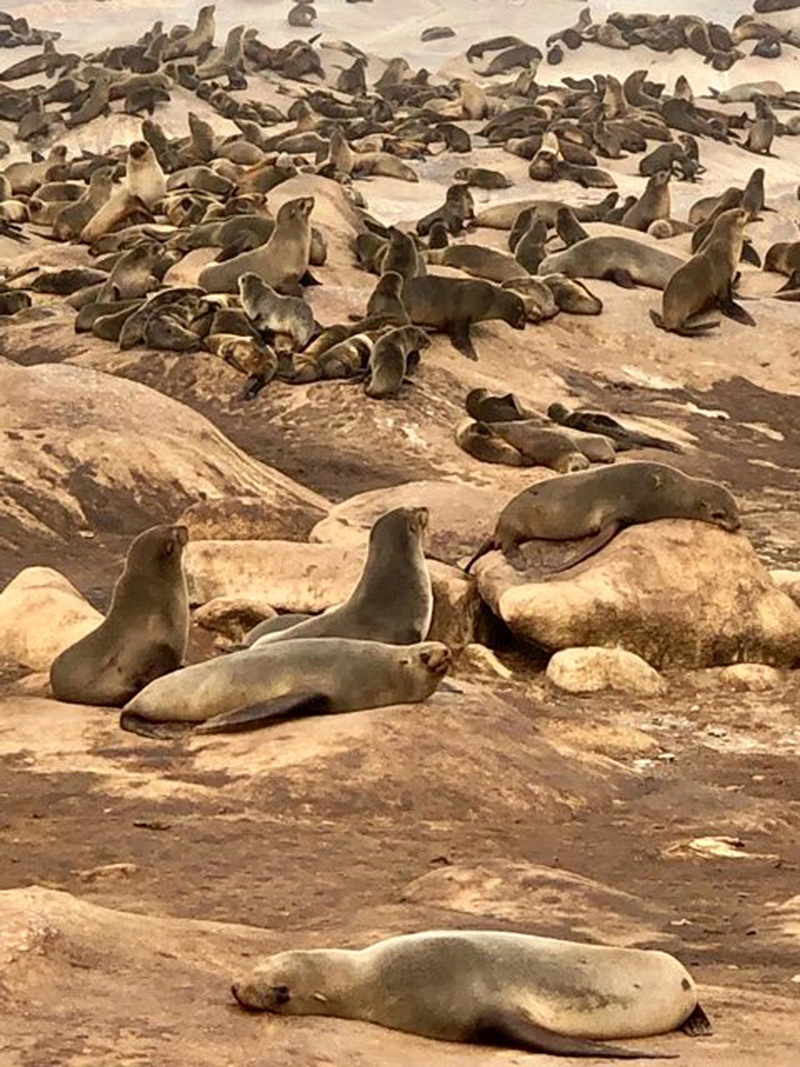
A very large community of Cape Fur seals enjoy a pleasant day on the coast. One can smell their fishy perfume and hear their barks and snorts from far away. In Namibia, there are more seals and springboks than people.
We only saw two (only two!) desert-adapted elephants and they have a smaller body mass, longer legs and wider feet. They must eat 100 percent of their body weight in scarce leaves, shoots and bark. We were told that one of them (his name is Danny) travels many days to reach the treeless Skeleton Coast and turns back inland to more moisture-laden mopane trees. He repeats this cyclical habit regularly. We also met Arnold, another elephant that ignored the watering hole provided for him and instead, tore up a water pipe in our camp because he could hear the water running through. Naughty.
A spectacular UNESCO World Heritage site, the Namib Sand Sea, a coastal fog desert, is a sight to behold (30,777 square kilometers). The biggest dunes in the world are located here and are protected by the Namib Naukluft Park. The red-orange sand dunes with their angles and stadiums are formed by constantly swirling winds. Tourists can walk up Big Daddy, 380 meters tall, the highest dune. At the bottom of Big Mama, the next highest, is Dead Vlei (lake), a waterless clay pan, with its 800-year-old petrified camel thorn trees.
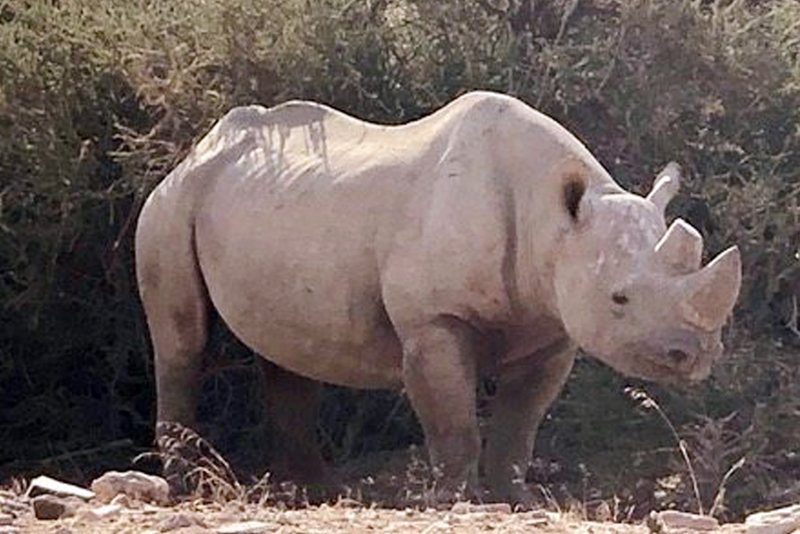
After a two-hour drive and another two- hour search by a rhino ranger, we found this beautiful, rare, black rhino ready for his morning nap under the shade of a bush. This rhino has been dehorned, to keep him safe from poachers. The sighting was well worth the bumpy (an understatement) ride through nonexistent roads.
In Sossusvlei, the Sesriem Canyon, three kms long, 30 meters deep, was formed by the Tsauchab River four to five million years ago. One can walk through into the dry gorge and actually touch layers of gnarled rocks.
The Skeleton Coast, in the northern part of Namibia, faces a rough and very cold Atlantic Ocean, the a sight of numerous shipwreck rotting away on the beach. The indigenous Bushmen call the region “the land God made in anger.” Other sailors call it “the Gates of Hell.” Fog, angry waves, damp sandy beaches laced with nutritious plankton foam for fish to partake of, is the setting for 100,000 Cape Fur seals happily barking away. (Trivia: Namibia has a population of 2.6 million. There are more seals and springboks than people.)
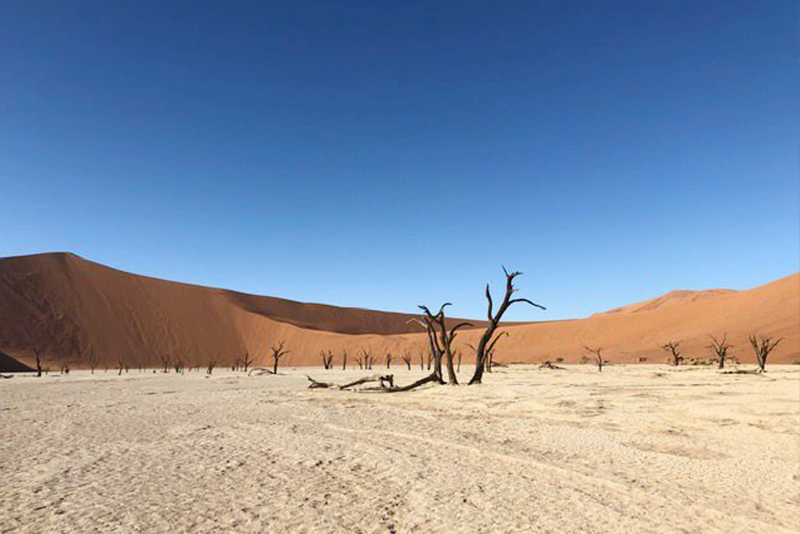
At the bottom of Big Mama, the second highest dune, is dry Deadvlei (dead lake), a white clay pan with petrified, 800-year-old camel thorn trees. The sand dunes encroached on the pan and blocked the water from the Tsauchab River. Due to the dry climate, the trees died, but did not decompose.
Diamond mines used to operate in the area. Our guide tells us that, in the past, rough diamonds could be picked up from the ground. While this is no longer possible, quartz crystal, garnet, mica and other minerals-in-the-rough are mixed with sand. You can pick up souvenirs, if you don’t mind overweight luggage.
The dry Hoarusib River bed is used as a road. (The word hoarisib means “water which twists and turns through a narrow gorge.”) It shows dramatic canyon walls of basalt and red volcanic rocks and fragile clay castles, thousands of years old.

Himba women are beautiful. Their color is enhanced because they bathe (water is only for humans and cows to drink) by rubbing a mixture of red ochre rock, herbs, and cow fat on their bodies. This concoction also acts as sunscreen and insect repellent.
In the Hoanib River Valley, our guide, Mamsy, drove over non-existent roads, following paw prints to catch a sight of a few desert animals. We needed a specially trained rhino ranger to look for the ever-shy, rare black rhino. After a two-hour drive and two hours of searching, we found this beautiful creature. His horn was sawed off, to protect him from poachers.
Desert lions are scarce. We only heard his roar one early morning, but did not see it. In fact, conservationists attach tracking devices to protect them. We were told that there is a problem between the local tribes who raise cattle and the lions. When a lion kills a cow, the government pays them only a fraction of the price the tribesman can sell their cow for in the market. This upsets the tribal folks, and they kill the lion, which upsets the conservationists.
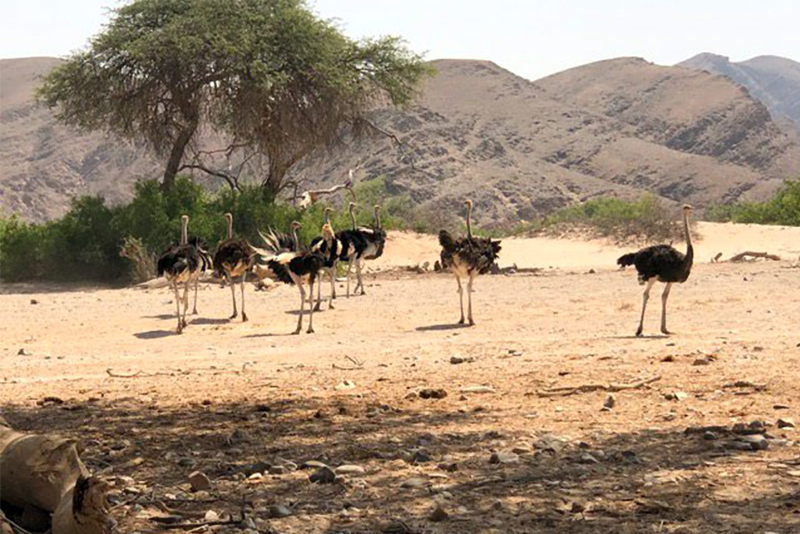
Ostriches, as well as springboks, oryxes, giraffes and zebras, enjoy a relatively predatorfree environment, since there are only a few desert-adapted lions and cheetahs around. Hyenas, jackals, and vultures are normally scavengers and will only eat carcasses.
There are patches of trees, wherever an underground river or spring provides the moisture they need. Really, one sees small puddles of water on what is called a river. There are also numerous “fairy” circles, two to 15 meters in diameter, where no grass or weed grows. Animals do not eat the grass that grows around these circles. Studies have been made, but are still inconclusive. There could be termites underneath or, maybe, aliens.
The endless expanse of sand and varied rock formations accompanied by tranquil silence is a magical yet humbling experience. The experience of flying over Namibia, and walking through its different terrains is something that leaves an indelible mark on the heart and mind.
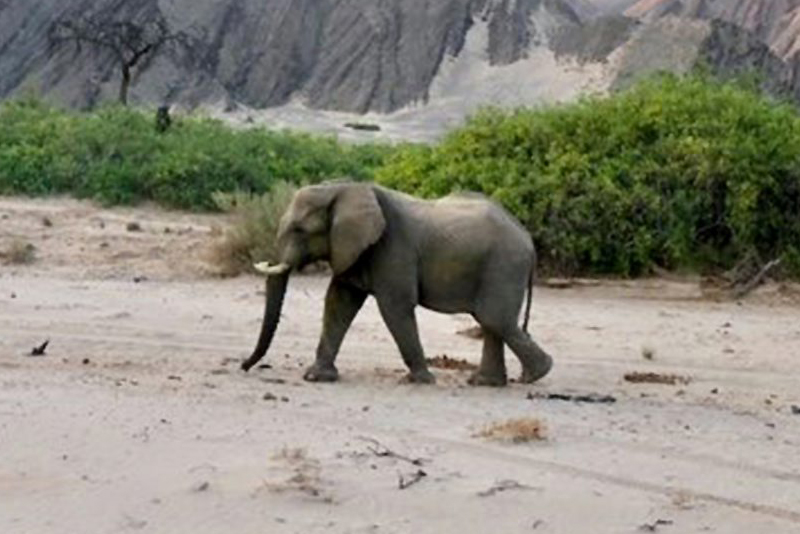
Desert-adapted Danny, the elephant, can walk many days with no need of water. He walks to the coast and then turns around, walks inland towards vegetation, and starts the cycle all over again.
As our pilot said, the landscapes of Namibia have been here way before us, and will be here after we are gone.
(PS: Namibia is not for first-timers to Africa. Should you want to be bitten by the “love Africa” bug, please visit the other “safari” countries first — Botswana, Kenya, Tanzania — to see many wild animals. Namibia is to fall madly in love with the country itself, without comparison.)
Also, it might interest readers to Google the words “Continental Drift Theory.” Africa and South America look like nesting parts of a jigsaw puzzle. They could have been one landmass before they drifted apart.

The last time water flowed through the Hoarusib River was three years ago. This riverbed, used as a road, exhibits dramatic canyon walls of black and red volcanic rocks. Holes on the rocks are made by the wind, home to many birds. From left: Mitto Licauco, author Cecilia Licauco, Corlu and Vic Caparas.
* * *
Please email me: cecilialicauco2@gmail.com
Instagram: cecilialicauco2



















